 |
| Sketch drawing, click to make bigger, or go the City site to look at the entire report. |
The Old Port area of Montreal:
Or even dusty ol’ Peoria, Illinois:
 |
| Sketch drawing, click to make bigger, or go the City site to look at the entire report. |
The Old Port area of Montreal:
Or even dusty ol’ Peoria, Illinois:
Short note, as I am getting really busy planning my December off (more on that later) and working on stuff that will fill our Januaries (yikes!), but I there is something important enough going on THIS WEEK that I wanted to add my voice to those getting the word out
It is a sad sign of our priorities as a society that the Ministry of Education will not pay for playground equipment at an elementary school. I like to think it is more reflection of the kind of Government that raises rates for the electricity needed to run schools, refuses to give the schools extra money to pay those rates, then tells the School Boards to just close some schools if they can’t afford to keep the lights on, as opposed to being the sign that our community doesn’t value our kids or recognize how important exercise and unstructured play is to learning outcomes… /end rant.
Clearly our community cares, as there is a group of aroused rabble who have been moving on a campaign to get funding from an Insurance Company to buy the playground equipment that an Elementary School should have at the new Elementary School called Qayqayt Community School which is being built currently on the old St. Mary’s Hospital site.
As the Aviva Community Fund is a national program, there are several programs competing for a few funds, but the good news is that this project has already jumped several steps in voting and promotion, and is a semi-finalist. They have 8 Days to get as many votes as they can. So go there and vote. Right now. You can even vote multiple times (once a day) and every person with a different e-mail address in your house, at your work, or in your universe can vote. Every day. So you, (yes you) can probably get 100 votes here.
The local group organizing this campaign has even made it easier for you by creating a webpage link to get you straight to where you can vote:
www.vote4robson.com
Here are the instructions sent to me by Tim Mercier from the École John Robson Community, and it was easier than the 7 steps below make it look, especially if you already have a Facebook account:
To Register;
1- Go to www.vote4robson.com
2- In the top right corner of the site (inside the yellow and above the search box) find “Sign in – Register – Francais” and click on “register” to get to the registration page;
3- Connect using your Facebook account or enter your email address and create a simple password for your account. Then scroll down the page to find the yellow “Register” button and press it;
4- Aviva will send you an email (to the address you used to register) and you will then need to open the email and click on the link;
5- This will bring you back to the Aviva page. The Sign in tab is located on the top right of the page in the yellow, click on it to go to the sign in page where you will need to enter your email address and password.
6- This will take you to your account page and Dashboard, if you want to find our entry either search for ACF17525 or just go back to www.vote4robson without logging off the Aviva site and it should get you there.
7- Once you have voted once, we will be in your supported idea tab and you can find us there.
Here you go, New Westminster – time for us to do what a great community like ours does best when a few people start a good idea – support them by showing up and give a few clicks to give the kids of the Downtown neighbourhood and all of the Qayqayt catchment a place to blow off steam so they can get some fresh air, learn better, and be healthier and happier #NewNewWest Citizens.
I know it isn’t really a New Westminster story, but there has been some local twitter buzz about the recently-announced changes in Ferry service, and I ride ferries a fair amount, so I have opinions… and that’s what you come here for, no?
First off, I do regularly ride the Southern Gulf Islands routes, as the NWimby-in-Law lives on the Jewel in the Strait that is Saturna Island. Saturna is the south-eastern most Gulf Island, and has a permanent population of about 350 people, although the population can swell to over 1,000 on a sunny summer long weekend. I note there is virtually no camping or hotels on Saturna; that summer swell is people fortunate enough to have “vacation property” or to have relatives or close friends on the island. The fixed population is just big enough to support a store and a pub, as long as the owners of both are more interested in serving the community than in making significant profits. It is a friendly, small community, and Beautiful.
It is also a community that will probably ostracize the hell out of me after reading the rest of this post.
Saturna is, based on all accounts from BC Ferries, one of those “Problem Runs”. To get there from Tsawwassen you take the SGI milk run to Mayne Island (“Route 9”), then switch to a Ferry bound to Swartz Bay that needs to do a little 20-km-return side trip to Saturna (“Route 9a”). The trip to Swartz Bay (“Route 5”) is a little more convenient, but still relies on the 20-km-out-and-back side route from Mayne or Pender (“Route 5a”). Saturna, even in the winter, sees no less than 25 sailings a week: 4 ferries depart from Saturna every weekday, three every weekend day. The boat is usually the Mayne Queen (70 cars and 400 passenger capacity), sometimes the slightly larger Queen of Cumberland (127 cars, 462 passengers).
It should be no surprise that these ferries are rarely full, or even close to full, in off-peak times (although they do get to overcapacity on those aforementioned sunny long weekends). During the recent route evaluations, the “Utilization Rate”* of the SGI runs are pretty low – 36% for the connection to Swartz Bay, and 43% for the link to Tsawwassen. A closer look at how the ferries are used show what that some rides are virtually empty – the first run to the Gulf Islands in the morning, and the last one back to the real world the evening, which average around 10% utilization. A simple solution, of course, would be to eliminate these two sparsely-used runs. Operational costs cut by 20% overnight! Right?
“For every complex problem, there is a solution that is simple, clear, and wrong”-H.L.Mencken
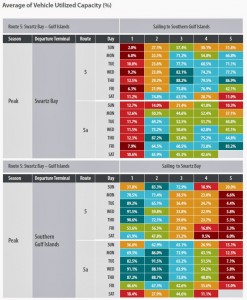 |
| Click to zoom in. Or go to the original source. |
See, the problem is the boat needs to return to Tsawwassen or Swartz Bay at the end of the day. They cannot be over-nighted at Saturna because the ferry crews don’t live on Saturna. Also, there are no re-fuelling facilities on Saturna, or all those little mechanical, restocking, overnight maintenance things that keep the ferries running.Economies of scale keep all of those things at Tsawwassen and Swartz Bay. This creates an interesting phenomenon. If you look (for example) at the Wednesday morning Route 5 sailing to the Gulf Islands, the utilization is an abhorrent 9.2% (yes, that is 6-9 cars, on average!), but the return trip on Wednesday Morning is 91.5% utilized. That second almost-full-on-average trip cannot happen unless that first virtually-empty trip happens. The same thing happens with the last run back to Swartz at the end of the day. It is virtually empty, but facilitates an almost-full last run to the Islands.
So complexities exist, and maybe that is why it appears the Southern Gulf Islands have escaped this round of cuts to service, and not because of the Premier’s property on Galiano Island.
The local twitter-chat I got involved in last week was about another aspect of this report. Whenever anyone starts talking about BC Ferries and funding, a few futurist-engineers-in-waiting start talking about just building a bridge and getting the whole damn thing taken care of. Once and for all, build a bridge, charge a $20 toll, and problem solved. There are only two problems with this idea: a $20 toll won’t nearly cover it, and the technology required for such a bridge does not exist on planet Earth.
The BC Ministry of Transportation has a good summary of previous studies into the crossing, but if I can summarize the problems, it would fill a paragraph. The distance is too long. The shortest practical bridge would be something like 25 km long. This would not be the longest bridge in the world, but it would be more than twice the length of the Confederation bridge, and it would definitively be the longest bridge over very deep water. How deep? That is problem 2: the Strait of Georgia is more than 350 m deep, which is higher than the highest bridge piers ever constructed (and they are over land, with the deck only 2/3 of the way up!). The seabed at that depth isn’t even something you can build piers on, as there is another 400m or more of loose muddy sediments, in an earthquake zone. The depth of loose sediments (combined with the length) also makes a tunnel impossible. The best that could be hoped for is some sort of floating-foundation suspension bridge – one that would allow large ships to pass, could manage 5 meter waves, a 3 knot tidal current and 100km/h winds. No such technology exists, but it was estimated (in 1980s dollars, mind you) that such a technology could be developed and built for $8 Billion to $12 Billion, over something like 15 years. Financing it would require $200-$800 tolls, one way.
Oh, and this proposed bridge would essentially replace the two BC Ferries coastal routes that are making money, leaving most of the money-losing ones still running. So the Fixed Link is definitively not our short-term solution to Ferries costs.
That said, it might be a more rational approach to take a close look at some of the smaller islands and explore the business case for connecting them by smaller bridges to reduce the need for inter-island ferry services. I could get drummed off Saturna and banned from Mayne for suggesting this, but the aforementioned 20-km return side run by ferry could be alleviated by building about 5 km of connecting roads on relatively flat (and pristine) land and two small bridges to connect Saturna to Mayne Island. This would disrupt several people’s property (not the least the private owner of Samuel Island), and I need to emphasise that this would require a solid business case, not some random blogger’s speculation, but there may be opportunities like this to be found across the system.
I will go on in a later post about some of the actual proposals put on the table this week by the Minister of Kamloops, but for now, I have to call the NWimby-in-law and warn her about the torches and pitchforks headed her way.
*As an aside, I question whether “Utilization Rate” a good measure for the effectiveness of a transportation system. I wonder what the “Utilization Rate” of the Pattullo Bridge is, or the Massey Tunnel. What % of the time are they 100% full? An hour or two a day? But I digress.
So much complaining and winging on this blog recently, I’m glad to talk about a good news story for a change!
I’m bully about the future of District Energy Utilities, and so it is good to hear New Westminster is starting to explore the prospect more seriously. The location in lower Sapperton provides an interesting collection of geographic opportunities that might make for a very successful system. But before the details, let’s do a quick primer on District Energy Utilities.
Like any other utility, a DEU is one where a single entity supplies the source and distribution system of a vital commodity, usually as a monopoly, and therefore covered by the BC Utilities Act. That Act assures the public can benefit from the inherent efficiency of a single supplier and integrated supply network, but that the consumer does not get gouged by the lack of competition. When you think of our drinking water supply or electricity grid, it is hard to imagine how else it could be managed. When it comes to “energy”, the concept is a little less clear.
An energy utility produces heat energy (usually through a boiler or heat exchanger), and distributes it (usually in the form of hot water or steam) to a selection of customers. For a variety of reasons, efficiencies can be found in producing the energy in a central site and distributing it widely, instead of having a small boiler in every building. This efficiency can be enhanced by building a larger-scale high efficiency system, and the sustainability of the entire utility improved by choosing a sustainable energy source.
Think about your typical apartment building. New ones generally have electric baseboard heaters around the periphery of glass-walled suites. This relies on the inherent efficiency of the province-wide BC Hydro electrical grid to be affordable, but at the local level, it is not in the least bit efficient. Older buildings are more likely to have boilers in the basement that burn natural gas and heat water which in turn circulates through the building to warm the rooms. The efficiency of this type of system relies on the efficiency of the boiler and the engineering of the distribution network in the building.
A DEU is like the second example. A single water-heating facility, and a system of pipes that moves hot water to the customer buildings. In each of those buildings, a high-efficiency heat pump turns the DEU-heated water into intra-building heated water, and distributes the warmth through the building. In theory, this entire system can also be designed to take heat out of the building in the summer, like any other heat pump.
There are several examples of DEUs operating in the lower mainland, and I have toured two of them. The first, and most famous, is the Southeast False Creek DEU. This is fast becoming the model of a “medium temperature” district energy system whose main energy source is the heat of sewage water.
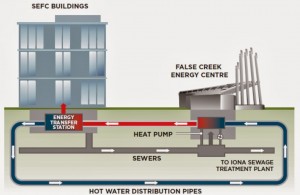 |
| Diagram from City of Vancouver website. |
There happens to be a big sanitary sewer line than runs by the site, and due to the fact we heat much of the water we use before we dispose of it, and there is so much …uh…organic activity in our sewage, it tends to be warm. There is so much warm sewage in this line that stripping off a few degrees of heat (the temperature exchanger reduces the sewage temperature by less than 5 degrees centigrade) results in a huge amount of energy to run the heat pump. There is enough energy that the system provides the vast majority of the heating and hot water for the buildings being built around the utility. The utility also has an efficient gas-fired boiler to “boost” the energy demand for those few days a year when Vancouver gets really cold and an exceptional amount of energy is needed. At full build-out, the sewage heat will supply about 70% of the total energy needs of the community.
The second example I have toured recently is in the Alexandria neighbourhood of Richmond. This is a very different system, although the fundamental idea is the same. The difference is that this is a “low temperature” system that relies on geothermal energy source. This energy source is a field of 250-foot deep metal loops with a coolant running through them.
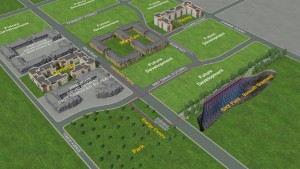 |
| Image from City of Richmond website. |
As groundwater a couple of hundred feet down is always around 12 degrees centigrade, the temperature between this temperature and heating season ambient temperatures is small (hence “low temperature”) but it still produces a surprising amount of energy. The system is also scaleable, and as the surrounding neighbourhood is built up and more energy is required, the system can be easily scaled up, using pretty much any energy source, from more geothermal to solar water heating to sewer heat (as the local waste water volume ramps up with development).
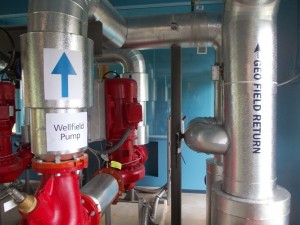 |
| When I toured the Alexandra energy centre, it still had that New Utility Smell. |
These systems provide significant benefits for users (as energy prices become more stable – not linked to volatile gas or electricity markets), for the environment (replacing fossil fuels and inefficient baseboards with a highly efficient heating system), and for the City that builds them (once the capital costs are paid off- about 10-20 years depending on the system, these utility systems should be a revenue source for the operator).
Back here in New Westminster, it appears from the report to Council, the proposed DEU will be a “medium temperature” variety, not unlike the Southeast False Creek system. This makes sense with the intensity of energy use from a relatively compact footprint. There is also the proposal to use waste heat from a major trunk sanitary sewer that happens to run right by the spot. Clearly, there are details to work out, but we are not inventing a wheel here, we are potentially benefiting from a system that is already successfully operating in hundreds of places, and has already proven itself to be financially sound and energy efficient.
The other option floated is to use a gasification plant to burn waste wood, which is the system that powers Victoria’s groundbreaking Dockside Green development, and also happens to be the system that the Kruger paper plant in New Westminster uses to produce power and steam, significantly reducing their greenhouse gas production by reducing the need to burn gas. I cannot emphasise enough this system is very different that a trash incinerator like the one in Burnaby. First off, the emissions from a gasification plant are remarkably low (and easily cleaned), and secondly, the waste wood represents biospheric carbon, not fossil carbon, so it does not increase the net greenhouse gas budget of the planet.
Actually, since both of these heat sources can be used on the same system, as they both represent “medium temperature” energy sources, and there is not reason (except maybe the economics of scale efficiencies) that the City cannot build both systems, in a staged approach as the Hospital expansion, the final pieces in the Brewery District, and other developments in the area take place.
So this is first steps, but it is good to hear the City is taking this idea seriously.
Long time readers (Hi Mom!) know I have been occasionally critical of Port Metro Vancouver. It is funny, because I work with people from the Port on occasion, and have healthy, respectful relationship with many Port staff. The first property upon which I ever led an environmental investigation during my consulting days was a Port property. They were great to work for because of their professionalism, straight-forward communications, and high competence of their technical staff.
So why the current hate on? Why am I taking part in, and encouraging you to participate in, a Rally on Sunday in New Westminster, with the Theme “Take Back Our Port”?
You can read about it in the Newspaper, or show up to get details, but this is about accountability.
Port Metro Vancouver is, to quote their website,
“a non-shareholder, financially self-sufficient corporation, established by the Government of Canada in January 2008, pursuant to the Canada Marine Act, and accountable to the federal Minister of Transport, Infrastructure and Communities”.
They are crown corporation who answer only to Lisa Raitt (who, like any other Conservative MP, answers only to the Prime Minister’s Office). There is no local representation of the Port, except a Board of Important Business People. They do a significant amount of public outreach, but there is no accountability to local residents in how they fulfill their mission, which is, again to quote the Website:
To lead the growth of Canada’s Pacific Gateway in a manner that enhances the well-being of Canadians
What is “Canada’s Pacific Gateway” exactly? Something to do with the Province, apparently, if you follow that link. But make no mistake, the Port doesn’t answer to the Premier, even if she leases her office space from them.
Regardless of catch phrases, the depth of the influence this unaccountable organization has on your community should concern you. A few of the hot-button issues that we talk a lot about in New Westminster point right back at the port: :
Coal: People in New West are very aware of the current proposal to introduce bulk coal exports to Surrey Fraser Docks, right across the Fraser from the Quayside. Most of you probably don’t know about the other two coal terminals in Vancouver are seeing expansion (Westshore Terminals expanded by 40% in 2012, Neptune Terminals in 2015 by 50%). With each expansion increases the number of open coal-carrying rail cars running through our neighbourhoods, increased air pollution, and increased climate impacts as we move the dirtiest fuel ever known to man. Although this expansion improves the financial bottom line of the Port, they are the agency charged with providing an “Independent” Environmental Assessment for the projects. They also make it clear that greenhouse gas impacts of their operations are not part of the assessment. GHGs are not their problem. That is the problem of the Federal Government, they say.
Trains: Train operations are dictated by Port needs. Trains are good, they are the most efficient way to move goods across land by far. If we are going to migrate our economy to a more sustainable path, trains will be a fundamental part of that economy. However, inflexibility in their operations, often dictated by Port needs, means that mitigating community impacts is difficult, and will always come in second place to logistical needs to keep things moving, as quickly as possible.
Further, impacts on the community are exacerbated by a failure to invest on rail infrastructure. The New Westminster Rail Bridge is more than 100 years old, and represents the largest goods-movement bottleneck in the region. This bridge, much like the Port, belongs to the Federal government, but there is simply no interest in replacing it. Therefore, more goods have to be moved by truck to bypass this bottleneck. Until this bottleneck is addressed, the re-alignment of the rails that run through New West cannot take place, and so we are all in a waiting pattern, hoping the rail/road conflicts will get better. Old rail infrastructure is also, like anything else, less safe infrastructure.
Trucks: Everyone in New Westminster knows we are being buried in truck traffic. The Port knows, but it frankly does not care. With the rail bottleneck, and complete disinterest from the Port in investing in short-sea shipping, containers are coming off ships at Burrard Inlet or Delta, then going on trucks, through our neighbourhoods and past our schools, to get to places like Port Kells or Port Coquitlam, to be put on trains, it’s clear moving stuff by truck is not an unfortunate consequence in our communities, it is the business plan.
This is further evidence when one looks at more recently-developed port lands, like Port-owned lands lining the north side of Queensborough and currently being filled with truck-only warehouses. Or look at the south side of Richmond, where the Port owns more than 750 Acres of waterfront land full of truck-only warehouses? These properties have something in common: no goods move on or off ships at these prime waterfront locations. Which brings us to:
Land Use: There has been an ongoing issue about the port encroaching on agricultural land, the threatening the ALR. We don’t have farmland in New Westminster, but regional food security should still concern everyone who hopes to eat for the next few decades. However, the Port is in a unique situation, where they can buy up large pieces of ALR land, which is relatively inexpensive at between $50,000 and $200,000 per acre (See Pages 28 and 29 of this report, I don’t make numbers up ) because of ALC restrictions on its use. Then, as a Federal Agency, they can, with a wave of the hand, remove the land from the ALR, and develop it for Industrial purposes. With undeveloped industrial land in the lower mainland selling for between $1,000,000 and $2,000,000 per acre, this seems like a pretty good business plan. Port puts up truck warehouses, asks the City to provide roads to service the trucks, and their financial self-sufficiency is all but assured. Good work if you can get it.
There is a strange meme being created by the current Port CEO– that an “Industrial Land Reserve” is needed to protect Port-related development. This is idiotic when viewed in the light of the equation above. Any land can be made industrial- you just need to pay the rates for that land that the market for industrial land requires. Further, once land become industrial, it can be re-purposed for other uses (see False Creek). The ALR land exists, because that is the one use that cannot be compatible with other uses- once a farm is lost to industrial development ,that land will never again be productive for traditional farming.
The current Port activity in Queensborough is a perfect model of this. High-value industrial lands were bought by the Port on the north side of Queensborough, east of the QB Bridge. Warehouses are being built to move things on and off of trucks. There is no plan whatsoever to use the waterfront location to move things on and off of boats; pier infrastructure is not even being built. The Port now owns the waterfront, and have paved it for the storage of trucks and trailers (with complete disregard to Riparian Areas protection standards or laws, which do not apply to them, because they are a Federal Agency, and with the closure of FREMP, the protection of the Fraser River riparian areas and waterfront habitat is now overseen by – you guessed it – the Port). The City’s and neighbourhood’s dreams of waterfront trails on Queensborough cannot be fulfilled because the Port will not allow a right-of-way through this same waterfront. Meanwhile, the trucks servicing these warehouses are backing up on Duncan Street and Derwent Way, creating havoc at the Howes Street intersection, and the Port is not responsible for any of the cost of improving this infrastructure. Meanwhile, the City has no say in any of this. Which brings us to…
Transportation. “Canada’s Pacific Gateway”, as mentioned above, is code for building roads and bridges. Under the guise of “goods movement”, the Port has been the main champion for spending taxpayer’s money on freeways and bridges that are out of scale for the region’s declining car use, unsustainable in their financing, and in complete contradiction to every regional transportation and land use plan created in Metro Vancouver over the last two decades. While everyone sat around for 20 years wondering where the money for Evergreen was going to come from, and while the Province floats a referendum to avoid having to make a decision about supplying enough funding the TransLink to keep the buses running, the Province has rushed ahead with $5 Billion on road expansion – from the Golden Ears Bridge (which is further crippling TransLink with debt) with the Pitt River Bridge (which is accelerating the removal of land from the ALR because of the traffic problems it has created), with the SFPR (which is a Port subsidy that destroys farm land and neighbourhoods), with the Widest Bridge in the World(tm) (which is also failing to meet its traffic targets and is looking like a long-term taxpayer pain), and now with the Tunnel Replacement to Nowhere. The Port has its fingers in every one of these decisions. They switch from consulting with the community to lobbying the Province in a flash, and then they are the agency that helps provide the Environmental Assessments for the projects. And greenhouse gasses? Someone else’s problem.
All of these issues are central to the livability of our City – of New Westminster, yet at every point, the Port’s only responsibility is to keep the money moving.
So come out to the family-friendly rally Sunday, and see how numerous people and groups feel about being kept out of the decision on how our community will develop, and how the livability of our region will be protected.
You have to be a real transportation/Port/Environment geek to know that this is going on, but I thought it might be interesting to call attention to one of Port Metro Vancouver’s current projects. The Port plans to expand DeltaPort- the big island created out next to the Tsawwassen Ferry terminal – to double the capacity for the movement of containers.
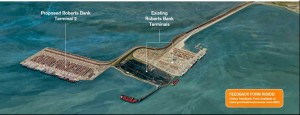 |
| PMV graphic, click to zoom in. |
They have just applied for an environmental assessment for the so-called Roberts Bank T2 Project, but are doing their own outreach to ask the community a few questions about the current project.
By “community”, I mean people South of the Fraser, because the pubic open houses are all being held south of the middle arm, but there is lots of opportunity for on-line comments, and with a comprehensive EA very likely, there should be more opportunity to talk over the next year or so.
My initial impressions are surprisingly (for some) not all that negative. However, before I present them, I need to do one of my every-so-often caveat things:
Although the footprint of this project is well outside of the City than employs me, my employer has been identified as a potential stakeholder in the project. I am in the department of the City that would theoretically be providing technical assistance to the City’s correspondence on the matter. That said, I have no pony in this race, nor have I any decision-making power in how EA or the Port plans advance, or how my employer approaches the EA. I am not privy to any behind-the scenes information, all I know about the project comes from the publicly-available records. Everything I say here is my opinion, not that of my employer or anyone else who may work for my employer, or any rational person, for that matter.
With that out of the way, I’ll give a quick description of the project. PMV wants to expand the container facility at DeltaPort. This is part of on-going expansion plans out there on Roberts Bank. To put the expansion in perspective, cast you mind way back to 2009, when Hannah Montana was still a thing, and the Roberts Bank Container facility had an annual capacity of 1.2 Million TEU per year (“TEU” is twenty-foot equivalent units, essentially a 20-foot long standard container. The ones you typically see on the back of trucks on Royal Ave are 40-foots, equivalent to 2 TEUs, although the 2.6 TEU 53-footers at are increasingly common).
In 2010 a third berth was opened, which boosted capacity 50%, to 1.8 Million TEU. Since then, an ongoing project to improve the rail and road connections and off-ship container handling is aiming to boost capacity by 2015 to 2.4 Million TEU. If approved and completed, the current project will boost capacity yet again, to 4.8 Million TEU. As full build-out of this project will not arrive until about 2024, the net result would be a quadrupling of container capacity over 14 years.
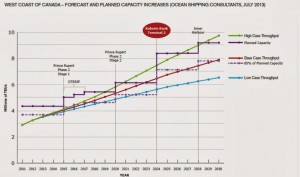 |
| PMV’s own graphics Click to make bigger |
Clearly, the Port is bullish on containers.
There is much to be discussed here, as the projected growth will impact every bit of our City and region. I want to concentrate on two specific issues at this early stage, both close to my heart. Transportation and the Agricultural Land Reserve.
Transportation
If you think there are too many container trucks on Royal Avenue now, what will it be like when container throughput is increased three-fold? Where are all these containers going to go?
I dug through this recent report commissioned by the Port, and used as the justification for expanded container capacity at Roberts Bank, and the existing terminals in Burrard Inlet. There are a few lessons in here.
First off, Surrey Fraser Docks will not be a significant mover of containers at the Port for the foreseeable future, regardless of the fate of the tunnel or dredging of the river. Simply put, the average every-day container ships being built today are too large to navigate within the Fraser River. At 400m long and 60m wide, their 15m draught is the least of their worries. Port facilities along the Fraser River may have many uses, but moving containers on and off of boats will not be one of them, unless the Port decides to finally start investing in the type of short-sea shipping that was recommended to them a decade ago by this other report.
Second, note from the graph above (page 36 of the aforementioned report) that the vast majority of the import containers, more than 90% from 1990 to 2010, are bound for destinations outside of Western Canada. The forecasts deeper in the report suggest this trend will continue, as most growth calculations are based on competitive advantages accessing the Mid-West and eastern parts of North America though rail. This should reinforce the question – why are we moving these things around by truck? What are the economics of moving these containers from the boat to the truck to the multi-modal yard where they eventually end up on trains?
Part of the answer might be train capacity. It has been suggested by people much smarter than me that the single most pressing goods movement choke point in the Province is the New Westminster Rail Bridge, underlying a challenged rail infrastructure throughout the region.
However, this report suggests quite the opposite- saying that there is lots of rail capacity, and that the economic advantages of direct-to-rail are clear:
“… the costs associated with trucking containers from terminals to rail yards were obviously highly uncompetitive. Hence, there was a switch in favour of on-dock rail facilities, and all new container terminals on the west coast either incorporate such a facility or provide on-dock access to an adjacent rail yard.” –pg 146.
So the economics make sense, the global trend is established, and the Port is making plans to take advantage of this reality. Which makes me wonder why we are still investing heavily in the building of truck-freeways to move trucks from the Docks to the Intermodal Yards? Why are we being told we have to accept the community impacts and cost to the public purse of all these container trucks when the economics don’t make sense?
There was one shocking statement a few pages later under Conclusions:
“The only possible difficulty if proposed oil exports from Alberta were to compete for rail space with coal and container trains. Clearly, the correct mode for these exports will be by pipeline. This is the only potential capacity constraint for increased container volumes via Vancouver.” -pg 150
I don’t think any of us were under any illusions about the Port being an interested partner in the building of pipelines to move bitumen from Alberta to the west coast, but this dynamic is one that shows how complex, yet strangely tenuous, our transportation network truly is. How Coal snuck into the discussion here is another point of speculation. Are plans for expanded coal movement really suited to the Port’s expansion plans for containers?
Agriculture / Land Use
The current Port Boss has been questioning the preservation of Agricultural lands. He has gone so far as to say we don’t need farmland in BC, as we can import all of our food through his port. So it is really hard to give him the benefit for the doubt about this topic…but hear me out a bit.
It is possible that the building of new land out where DeltaPort is currently located will reduce the pressure to re-purpose existing new land in the lower Fraser Valley from farm to Port servicing. If we accept that the Port’s expansion models are realistic, and we accept that expanded movement of container goods is a great thing for our economy, and Roberts Bank Terminal 2 is designed to primarily move goods on and off of boats and on and off of trains (three big “ifs”, admittedly), then of all the places for this activity to take place, perhaps Roberts Bank is the best option. Maybe this is a project that Environmentalists can somehow “get to yes” on (to borrow the parlance of the day).
The habitat loss out on Roberts bank will be small, and adjacent to already highly disturbed habitat. With some creative design, there is no reason T2 would create any harm outside of its 100 hectare footprint. It could be argued that compensatory habitat required under the Fisheries Act will be of higher quality than that lost through this project, but that is yet to be seen, and something that will come out during the EA.
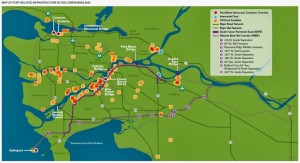 |
| PMV Graphics, Click to zoom in. |
Public meetings:
There will be 5 public meetings, starting tomorrow, led by the Port, and discussing three aspects of the project: Habitat Mitigation Plans, Methods for improving Port-related truck traffic; and ideas for community legacy benefits. As I said, they are all South of the Fraser, but you might want to make the trip and check them out:
October 16 @5:00pm-8:00pm UBC Boathouse, Richmond
October 17 @5:00pm-8:00pm Surrey Arts Centre, Surrey
October 22 @5:00pm-8:00pm Coast Hotel , Langley
October 24 @5:00pm-8:00pm Delta Town & Country Inn, Delta
October 26 @10:00am-1:00pm Coast Tsawwassen Inn, Delta
There’s been a lot of talk about a new bridge in New West. Some love the idea, some hate it. Paradoxically, those who will use it the most (those right next to it) hate it the most: at least those on the north side of the crossing. Those on the south side seem to insist a better connection is needed.
The initial designs were met with much gnashing of teeth and rending of garments. The consultation was a sham! The options were not viable!! The neighbourhood will not stand for it!!! Pleads of urgency and need were tempered by vaguely Nimby-esque calls for caution and/or outlandish alternatives. Loggerheads were met. Funding sources were debated, petitions were signed, Council was implored.
So the responsible agency hit Ctrl-Alt-Del; sent the engineers back to the drawing board to re-evaluate and return with better options. Third parties were brought in to consult. Previously-discarded options were reconsidered. Numbers were crunched, common ground was sought, new sketches were proffered. More than a year later, the conversation is re-booting, and it is time for you to provide your input. Yet again.
I am talking, of course, about the proposed Quayside to Queensborough pedestrian crossing (what else?).
The people of New Westminster are being asked to comment right now on the two options that have been pencil-sketched for us. We have on-line info, there has been a travelling “whattya think of the bridge now” road show at most recent community events, Ted Eddy has expressed his opinion(s), and all that is left is for you to spend 5 minutes filling out the quickie questionnaire. You have until October 16, 2013.
Allow me to opine.
The current proposals address one of the biggest challenges for the project as originally conceived: the Navigable Waters Act requirement that there be 22 metres of air above the River to allow medium-sized ships to pass into and out of the North Arm of the Fraser River. Less than 22m, then the bridge has to be openable, like the current swinging train bridge in the location.
The engineers have come back with two options to avoid the 22-m high bridge that made for an opposing edifice and a challenging ramp for the less-able-bodied. “Option A” is a bridge that coalesces with the swing span of the existing train bridge, and opens and closes with the rail bridge. “Option B” is a bascule design, which is a drawbridge common to medieval castles and the Chicago River. This would be build adjacent to, and separate from, the train bridge. Each have advantages and disadvantages.
Note there is a language issue here. When talking about a draw or swing bridge, relativity rules the use of the terms “open” and “closed”. Since I (and presumably you) see this as primarily a piece of pedestrian infrastructure, “open” would mean you can walk across it, and “closed” means you cannot. This differs from the mechanical and nautical view of an “open” drawbridge being one where boats can pass. So just to make things clear: when I say open, I mean closed to boats; and when I say closed, I mean open to boats. Clear?
The primary advantage of Option A is cost. The study suggests the entire bridge can be built for $5 Million, which is less than the remaining DAC funds that have been allocated for the project. The bridge will also be slightly lower with shallower ramps and less visual impact for residents.
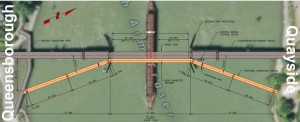 |
| OPTION A: You can click the image to zoom in. |
There are however, significant negatives related to this option, mostly related to being literally mated to the existing rail bridge. The owner of the bridge (Southern Railway / SRY Rail Link) has indicated that pedestrians will not be permitted to use the bridge while a train is present (currently, about 8 trains cross the bridge every day) which could cause significant delays for people hoping to cross the bridge.
 |
| OPTION A: You can click the image to zoom in. |
The existing train bridge is 100 years old, and there are some questions about the longevity and engineering reliability of that crossing. Attaching a multi-million dollar piece of City infrastructure to a privately-owned piece of infrastructure approaching the end of its service life may not be the most prudent choice, and may represent “penny wise, pound foolish” planning. What happens to that investment if the rail owner decides to replace their aging bridge in 10 years? What if a moderate seismic event or barge collision closes the rail crossing for an indefinite period? What are the odds SRY’s business plans will change at some time in the 75-year lifespan of a pedestrian crossing? Arguably, these issues may be managed through a deftly-negotiated agreement between the SRY and the City, but some risks will still be there for future administrations to deal with.
Option B will be higher than the existing rail bridge. With 9.6 metres clearance above high water mark, it will not be so big that the on-ramps will be daunting, but high enough that many of the boats that pass the rail bridge will not require the pedestrian bridge to be opened (um… closed). Current estimates have the Option B bridge being open for boats less than half as often as Option A. It will also not be tied physically to SRY’s bridge, so changes in rail operations or replacement of the century-old wooden structure will not adversely impact the accessibility of the pedestrian crossing. This is all good.
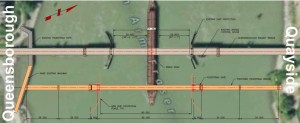 |
| OPTION B: click to make bigger. |
The downside, of course, is the increased cost. At an estimated $9.6 Million, there will need to be a second funding source aside from the remaining DAC funds. The City will have to shake out the couch cushions or borrow to fill the funding gap and get the job done.
 |
| OPTION B: click to make bigger. |
When discussing the Q2Q pedestrian crossing, people talk about it in different terms. Some think of it as a nice amenity, a connection between neighbourhoods, an extension of the park system or a tourist draw. I think of it as all of these things, but primarily as a vital piece of transportation infrastructure. With this in mind I quote myself:
Ultimately, I only hope the crossing will be reliable – one you can count on being there when you need it, and not unexpectedly opened [sic] for a hour at random times – because I see this bridge primarily as a transportation link… then it will be the link we have been missing up to now.
So I vote for Option B.
As for the money, let’s go back in time a bit. The DAC funding was part of a negotiated package the City worked out with the Province over permitting for the Casino. The original allocation of $60 Million looked like this:
$5 M for park improvements across Queensborough;
$35 M for a Multi-use Civic facility in downtown;
$6 M for a new and improved Queensborough Community Centre;
$4 M to improve the docks at the Quay;
$10 M for a Quay-to-Queensborough pedestrian crossing.
The two Queensborough community projects have been delivered: Parks in 2011, the Community Centre in 2013. Last year, the City decided, and received permission to, “reallocate” $8 Million from the last two projects to the MUCF, which became the Anvil Centre. They more recently announced the dock program is not likely to happen any time soon. That leaves $6 Million for the Q2Q Bridge.
Back when the original Q2Q Bridge plan estimates came in around $20 Million, the difference between $10 Million and $6 Million in available DAC funding seemed a little academic- they were still going to have to pop for a significant amount of money to fill the gap. So transferring some of that money with uncertainty attached to the much more certain (as there was a hole in the ground having cement poured into it) seemed like a good idea at the time.
Now that the revised, reasonable, and more acceptable to the community “Option B” estimate is $9.8 Million, the City has a bit of a problem. What to do when the better option is within your original committed budget, but you have now re-allocated such that there is only enough left to pay for the lesser option?
I have already opined about the potential to replace the Massey Tunnel back when the rushed “consultations” were launched in the Spring. People with better minds than mine have already challenged the base assumptions built into the apparent need for a replacement using the Ministry of Transportation’s own numbers.
This week’s announcement that this low-priority election bauble was pushing on, full steam ahead, despite the objection of pretty much every Mayor in the region* except for the one who doesn’t want to pay for it, is still a little confounding. Our all-but silent rookie Minister of Transportation continues to dither about Transit funding models and a still-born referendum, everyone from Teachers to Nurses to Social Workers are being told there is no money in the kitty for any of their essential programs, but for some reason this multi-billion dollar boondoggle is a Provincial Priority. Depressing, but not shocking.
Since the announcement was amazingly bereft of details: size, scale, scope, costs, tolls are all things we can only speculate on. The only substantive thing we have to base our speculations upon is the fly-through animation of the proposed bridge, a fanciful piece of salesmanship no doubt created in a wet dream by the very engineering firms and Project Managers that are now engaged by the Ministry of Transportation to sell this product to a reluctant taxpayer consult on the project design and implementation on behalf of the Government, so they can eventually get paid by the same Government to build it. You know who you are.
First off, note the lane count. 10. Well, 12 if you include the “safety lanes” that appear to be full-lane width on this rendering. Plus a bike/pedestrian path. As drawn, this bridge will be wider than the Port Mann, the alleged widest bridge in the world.
Yes, two of those lanes will be “HOV” lanes. Note the HOV lane is dominated by cars and commercial vehicles, which makes them very different than the HOV lanes we know and love.
Note no substantial changes to the design of the Steveston Highway intersection as far as lanes in and lanes out, (although it looks like the overpass will be blown out to 4 lanes, which will not do much for Stevenson and No 5 Road). Note especially how the free-flowing traffic from the new bridge disappears as it exits to the 2-lane Steveston Highway, as if by magic. The magic of road builder renderings. That traffic is distinctly “somebody else’s problem”. Or the next problem they will get paid to solve.
Nor do will see substantive changes to the Highway 99 / Highway 17A intersection. Except, of course, the current 6-lane Highways that extend through farmland away from the Bridge north and south are shown to be 10 lanes wide as far as the eye can see. Pity the Oak Street Bridge, I-5 Seattle, here we come.
Note the pedestrians on the bridge. There are a dozen pedestrians and three cyclists shown. Cyclists I’ll give you, but the bridge is 3 km long, with the north end ramp more than a kilometre from the nearest doorway of any kind, and the south end something like 5 km from any likely destination, be it residential, commercial or recreational. Where the hell are these walkers going?
Perhaps they got tired of waiting for the transit that never showed up, as the established bus stops on the Richmond side of the bridge have been removed, and the HOV lane moved to the middle of the freeway, so Transit connections have clearly not been thought out here. Probably TransLink’s problem to solve.
At least I give the rendering props for truthfully representing the types of vehicles that use the Massey tunnel route. In the animation, 83% of the vehicles shown are private cars, 14% are commercial trucks, and 3% are buses. Admittedly, they are “tour” bus types but let’s assume the animator meant for these to be ultra-luxury Transit buses that will come with expanded Transit funding to go with the new road (yes, that was sarcasm).
These stats are close to the actual current count of traffic going through the tunnel: 87% cars (including HOV, which means at least one passenger), 12% trucks, 1% transit.
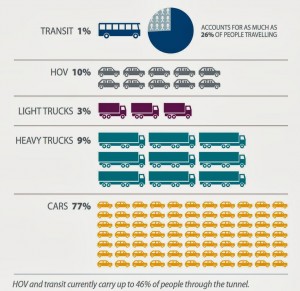 |
| Source: Massey Tunnel Replacement Consultations. |
Actually, the 2% increase in trucks is almost exactly the increased number that will result from the most ambitious Port expansion plans at Terminal 2. Keep that 2% number in mind when you are told “Goods Movement” is a primary reason for spending a couple of billion of your dollars to replace the tunnel.
In contrast, the displayed tripling in transit service is clearly fanciful, as TransLink has no money to maintain the routes they currently run. This is important, because if transit use (which at 1% of vehicles, already represents 26% of the people travelling through the tube) tripled, then the numbers of cars going through the tunnel would be reduced by half. Which would end our congestion problem for a much lower cost than a $X Billion bridge.
Alas, I heard Moe Sihota speaking for the NDP on the Rick Cluff Radio Confrontation Hour (follow link to about 1:50:00) this morning, also agreeing that the tunnel needed to be replaced with a big shiny bridge, using the same incorrect data and false assumptions as Premier McSparkles(Tm). Of course, he disagreed with Colin Hansen on some arcane aspect of the funding or the opportunism of the announcement, but he was all for pissing away you tax dollars entrenching another generation of motordom.
This leaves the 100,000 daily transit users on the under-serviced Broadway Corridor and the tens of thousands in Surrey loading on stuffed and increasingly unreliable SkyTrains every morning wondering who represents them.
Remember that whole Downtown Parking Strategy and the concomitant “Tear Down the Parkade” movement? What ever happened with that?
There are two recent news stories that are directly relevant to this study, both about newly-proposed developments in the Downtown.
The first development plan is for a location in deep need of redevelopment: the mid-block area on the north side of Carnarvon across from Plaza88. The so-called Carnarvon Gardens (ugh…) development is creating a bit of a disagreement on Council because of various challenges in providing parking space and the impact on the neighbourhood form.
At least part of the reason for debate here is the location across the street from Plaza88, whose own parking situation is an ongoing cause of chagrin. As I have said many times before, Plaza88 is a great idea as far as Urban Planning, but suffers from some poor execution as far as Urban Design. One of those issues is the wall of parking lots that provide the facade of the building. The multiple stories of above-ground parking exacerbate the canyon effect on Carnarvon, at least partly because it is not “human space”, but machine space. If that facade was windows and balconies with evidence of human life, the effect would be much more gentle. If it was set back from the street by a few metres, it would be even better.
The proposal for Carnarvon Gardens, right across the street, is to have a similar 5 stories of above-ground parking, but to hide most of them behind a wall of office/commercial space, much like the bottom two floors at Plaza88. The top floor would not be so obscured, nor would the Victoria Street facade or the little side-lane that connects Victoria and provides access to adjacent buildings (9th Street?).
The development looks great- (you can see it in these Meeting minutes, starting down on page 88) – 23K sq.ft of office space, 10K sq.ft. of retail, and 198 residential units. But even back in July, Council asked questions about the plan for parking. Originally, 308 parking spaces on 7 floors (2 underground and 5 above ground, at least on the Carnarvon side) was proposed, although the current Bylaw requires 353 spots. After sending the July plan back for more consideration, the proponent came back with a similar proposal (two underground parking floors, five above ground) but have now reduced the number of parking spots, based on two studies.
The Downtown Parking Plan study suggested 278 parking spots were required here, where the Proponent’s own study indicated 260 were required to service the building’s needs. The Proponent, however, is willing to build 294 spots- as they figure that is the magic number that balances the cost of building parking with the “marketing goals” for the condos. They also balked at the idea of moving the exposed 5th floor parking down underground where it will be out of site, presumably because of increased costs.
During discussion at Committee, Councillor McEvoy raised an excellent point, in that there will be a time (perhaps now?) that we stop thinking about the street presence on only one side of a building. This development “backs” on Victoria Street, but other businesses and potential future developments front on Victoria. So why is a parking lot facade that is not acceptable on Carnarvon acceptable on Victoria? If we want the best revenue-generating and job-creating parts of our renewed Downtown to expand, then we cannot afford to create more “dead space” roads. More imagination is needed here.
The second development plan is much more preliminary, according to this story, but has many parallels other then being three blocks to the east. This building will have 7,500 sq.ft. of commercial and 282 residential units, planned for rental as opposed to market condos. Here, the Bylaw parking requirement is 410 spots, the Downtown Parking Study suggests 218 are needed, but the Proponent is proposing 169.
So two concurrent (or close enough) developments one block uphill from Columbia Street, and both want to save money by not building parking. A bit of quick math gives us:
Bylaw Requirement: 763 total spaces.
Parking Study demand: 496 total spaces.
Proposed to be built: 463 total spaces.
So depending on how you count it, there are between 33 and 300 parking spots being left on the table. These are spots the Developer is required to install according to existing City policies, but is asking for an exemption because they won’t make any money from them.
Now compare those numbers to the “peak use rate” of the Front Street Parkade according to this report to council. 38% of 800 parking spots is 304. Now you (hopefully) see where I am going.
This is, ultimately, the solution to the Front Street Parkade problem – distributed parking in new developments. I’m not saying both of these buildings need to build parking to 100% of their (now dated) Bylaw requirements, but there needs to be a discussion about how new developments provide public parking at rates similar to the Parkade. 30 to 50 lots in each new building, the construction paid for by the Developer and the rental income going back to the Developer (unless, of course, they choose to sell the parking lot rental business off) to offset the cost.
Instead of pulling into a decrepit waterfront white elephant, one can find public parking in any of a half dozen buildings within a block or two of your destination. And we get a major part of our waterfront back.
This is not as easy as it might seem, though. We need to convince the Developers that it is worth their time and money. We also need to worry about the urban form issues that Councillor McEvoy raised, and that threaten to make Carnarvon and other streets into car park canyons. However the first step is to stop handing out variances for every new building so Developers can save the hundreds of thousands of dollars it takes to provide market parking. Instead, we need to create the market incentives to make it worth the Developer’s time to install public parking as part of every new large development.
As for the Parkade, it is not giving up without a fight. It has apparently been exposed to Gamma Rays, and vents its occasional rage through Twitter:
So there’s that.
This is a story with more layers than an onion, and is so absurd that it should be in the Onion.
The City of Pitt Meadows, against the protestations of its citizens, wants to fix a traffic problem by building a big-box retail strip mall on 80 acres of ALR-protected farmland.
Read that again. That is the case Pitt Meadows successfully made to the Agricultural Land Commission.
Boggles. The. Mind.
The longer version of the story is thus:
You see, Old Dewdney Trunk Road (ODT Road) is a rural two-lane that runs through farmland in Pitt Meadows north of Lougheed Highway. Mostly protected from development by the Agricultural Land Reserve, the ODT Road area is mostly larger farms, and protected from the strip mall and low-density housing explosion that has grown around Lougheed Highway – stretching almost undisturbed from Coquitlam Centre to Haney. Problem is, being the “back route” around the inevitable Lougheed Highway congestion, ODT Road is suffering from more traffic than the old rural two-lane is designed for.
This problem was apparent in the 1990s, but Pitt Meadows was not all that concerned, because the Pitt River Bridge was being expanded, and more lanes of Lougheed were being built. As a bonus, the Golden Ears Bridge was coming to take some of the traffic load off of Pitt Meadows, and a brand new semi-express way was being blasted through farmlands to the east, providing easy access to the Golden Ears Bridge for all those single-family homes that have been built out around Abernethy Way, which was all, notably, farmland less than 30 years ago. Pitt Meadows was not worried, because with all these new roads being built, traffic congestion on Lougheed would soon be a thing of the past- and ODT Road could go back to serving local farmers.
Except, of course, the roads did not take the traffic away, the roads brought more traffic. With easy highway access came more single-family homes that can not be served adequately by transit when TransLink is cutting services, and came more strip-mall retail shops to serve the needs of the growing car-dependent community. Few real family-supporting jobs are created in these strip malls, so people cannot actually work near their single-family home, and commuter traffic inevitably got worse, not better, with the new roads. That is what we call Induced Demand.
So the City of Pitt Meadows, shocked (shocked!) that these new roads have not fixed their traffic problem, has found a solution: one more road. This is where we get the proposed “North Lougheed Connector”. Problem is, after the Ministry of Transportation blew their budget on the Pitt River Bridge and Lougheed Highway improvements to fix the traffic problem in Pitt Meadows, and TransLink is bleeding through the ears in part because of a shitty Golden Ears Bridge toll deal that was supposed to fix the traffic problem in Pitt Meadows, neither have the money to build this one last road that will finally fix the traffic problem in Pitt Meadows. Even with all the single-family home building and strip malls, Pitt Meadows doesn’t have the money to fix the traffic problem in Pitt Meadows.
Along come Smart Centres, strip-mall builders of some fame. They have the money to fix the traffic problem in Pitt Meadows. They are more than happy to build a short stretch of highway through land they don’t own (because like the Golden Ears Way, and a fair chunk of the South Fraser Perimeter Road, the North Lougheed Connector will be built on protected ALR land, no need to exclude from the ALR for roadbuilding, alas). Only catch is that the new road has to include off-ramps to their parking lots for their new strip mall. The parking lots and strip mall they want to build happen to be on land they bought at ALR rates, and that they will lease out at Commercial rates now that they can get more than 80 acres of that that cheap land out of the ALR just for building a road through more ALR. Good business if you can get it.
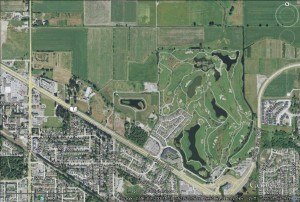 |
| The 80 Acres in question is between the golf course and Harris Road. Click to enlarge. |
It is the circle of progress: build low-density housing on ALR land, build freeways and bridges to access them (if someone suggests alternatives like density, transit, or bike lanes, cry “tax grab!”), when traffic gets too busy, build more roads, take more land out of the ALR and build houses on that land to fund it, lather, rinse, repeat.
So why do I, a local blogger in New Westminster care about Pitt Meadows strip malls? Because this is, boiled down to its essence, New Westminster’s traffic problem. When TransLink or the Ministry of Asphalt talk about the North Fraser Perimeter Road– turning local New Westminster streets into highways for through-traffic, it is this strip mall in Pitt Meadows that will be at the east end of that highway. Traffic problems being generated by bad planning in the Pitt Meadows (Surrey, Langley, etc.) today will be used as an excuse to destroy the livability of New Westminster.
The ALR does more than protect agricultural land, it protects the livability of our region. Don’t let Bill Bennett destroy it.